Geometric Optics and Image Formation
Thin Lenses
Samuel J. Ling; Jeff Sanny; and William Moebs
Learning Objectives
By the end of this section, you will be able to:
- Use ray diagrams to locate and describe the image formed by a lens
- Employ the thin-lens equation to describe and locate the image formed by a lens
Lenses are found in a huge array of optical instruments, ranging from a simple magnifying glass to a camera’s zoom lens to the eye itself. In this section, we use the Snell’s law to explore the properties of lenses and how they form images.
The word “lens” derives from the Latin word for a lentil bean, the shape of which is similar to a convex lens. However, not all lenses have the same shape. (Figure) shows a variety of different lens shapes. The vocabulary used to describe lenses is the same as that used for spherical mirrors: The axis of symmetry of a lens is called the optical axis, where this axis intersects the lens surface is called the vertex of the lens, and so forth.
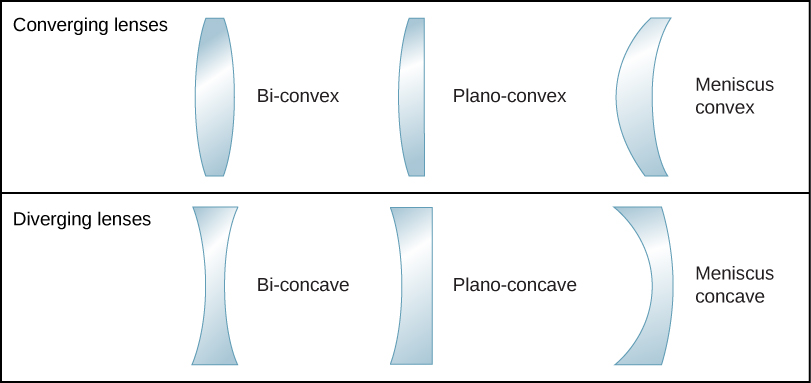
A convex or converging lens is shaped so that all light rays that enter it parallel to its optical axis intersect (or focus) at a single point on the optical axis on the opposite side of the lens, as shown in part (a) of (Figure). Likewise, a concave or diverging lens is shaped so that all rays that enter it parallel to its optical axis diverge, as shown in part (b). To understand more precisely how a lens manipulates light, look closely at the top ray that goes through the converging lens in part (a). Because the index of refraction of the lens is greater than that of air, Snell’s law tells us that the ray is bent toward the perpendicular to the interface as it enters the lens. Likewise, when the ray exits the lens, it is bent away from the perpendicular. The same reasoning applies to the diverging lenses, as shown in part (b). The overall effect is that light rays are bent toward the optical axis for a converging lens and away from the optical axis for diverging lenses. For a converging lens, the point at which the rays cross is the focal point F of the lens. For a diverging lens, the point from which the rays appear to originate is the (virtual) focal point. The distance from the center of the lens to its focal point is the focal length f of the lens.

A lens is considered to be thin if its thickness t is much less than the radii of curvature of both surfaces, as shown in (Figure). In this case, the rays may be considered to bend once at the center of the lens. For the case drawn in the figure, light ray 1 is parallel to the optical axis, so the outgoing ray is bent once at the center of the lens and goes through the focal point. Another important characteristic of thin lenses is that light rays that pass through the center of the lens are undeviated, as shown by light ray 2.
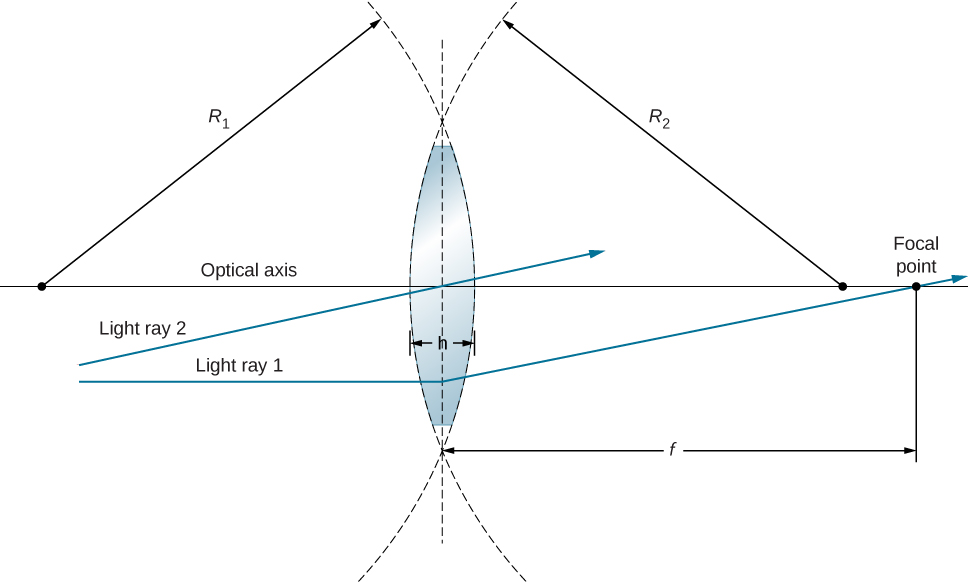
As noted in the initial discussion of Snell’s law, the paths of light rays are exactly reversible. This means that the direction of the arrows could be reversed for all of the rays in (Figure). For example, if a point-light source is placed at the focal point of a convex lens, as shown in (Figure), parallel light rays emerge from the other side.

Ray Tracing and Thin Lenses
Ray tracing is the technique of determining or following (tracing) the paths taken by light rays.
Ray tracing for thin lenses is very similar to the technique we used with spherical mirrors. As for mirrors, ray tracing can accurately describe the operation of a lens. The rules for ray tracing for thin lenses are similar to those of spherical mirrors:
- A ray entering a converging lens parallel to the optical axis passes through the focal point on the other side of the lens (ray 1 in part (a) of (Figure)). A ray entering a diverging lens parallel to the optical axis exits along the line that passes through the focal point on the same side of the lens (ray 1 in part (b) of the figure).
- A ray passing through the center of either a converging or a diverging lens is not deviated (ray 2 in parts (a) and (b)).
- For a converging lens, a ray that passes through the focal point exits the lens parallel to the optical axis (ray 3 in part (a)). For a diverging lens, a ray that approaches along the line that passes through the focal point on the opposite side exits the lens parallel to the axis (ray 3 in part (b)).
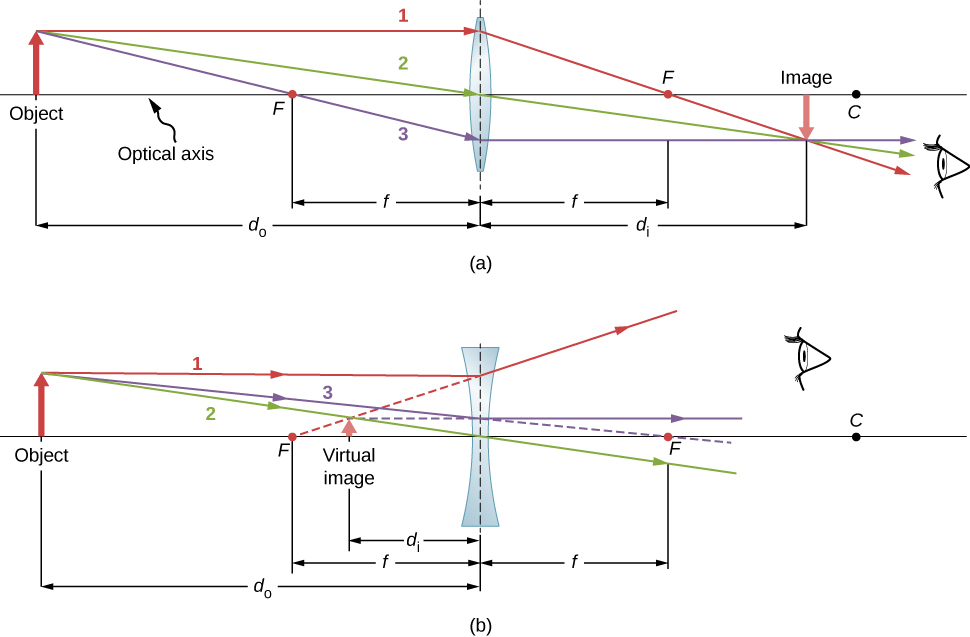
Thin lenses work quite well for monochromatic light (i.e., light of a single wavelength). However, for light that contains several wavelengths (e.g., white light), the lenses work less well. The problem is that, as we learned in the previous chapter, the index of refraction of a material depends on the wavelength of light. This phenomenon is responsible for many colorful effects, such as rainbows. Unfortunately, this phenomenon also leads to aberrations in images formed by lenses. In particular, because the focal distance of the lens depends on the index of refraction, it also depends on the wavelength of the incident light. This means that light of different wavelengths will focus at different points, resulting is so-called “chromatic aberrations.” In particular, the edges of an image of a white object will become colored and blurred. Special lenses called doublets are capable of correcting chromatic aberrations. A doublet is formed by gluing together a converging lens and a diverging lens. The combined doublet lens produces significantly reduced chromatic aberrations.
Image Formation by Thin Lenses
We use ray tracing to investigate different types of images that can be created by a lens. In some circumstances, a lens forms a real image, such as when a movie projector casts an image onto a screen. In other cases, the image is a virtual image, which cannot be projected onto a screen. Where, for example, is the image formed by eyeglasses? We use ray tracing for thin lenses to illustrate how they form images, and then we develop equations to analyze quantitatively the properties of thin lenses.
Consider an object some distance away from a converging lens, as shown in (Figure). To find the location and size of the image, we trace the paths of selected light rays originating from one point on the object, in this case, the tip of the arrow. The figure shows three rays from many rays that emanate from the tip of the arrow. These three rays can be traced by using the ray-tracing rules given above.
- Ray 1 enters the lens parallel to the optical axis and passes through the focal point on the opposite side (rule 1).
- Ray 2 passes through the center of the lens and is not deviated (rule 2).
- Ray 3 passes through the focal point on its way to the lens and exits the lens parallel to the optical axis (rule 3).
The three rays cross at a single point on the opposite side of the lens. Thus, the image of the tip of the arrow is located at this point. All rays that come from the tip of the arrow and enter the lens are refracted and cross at the point shown.
After locating the image of the tip of the arrow, we need another point of the image to orient the entire image of the arrow. We chose to locate the image base of the arrow, which is on the optical axis. As explained in the section on spherical mirrors, the base will be on the optical axis just above the image of the tip of the arrow (due to the top-bottom symmetry of the lens). Thus, the image spans the optical axis to the (negative) height shown. Rays from another point on the arrow, such as the middle of the arrow, cross at another common point, thus filling in the rest of the image.
Although three rays are traced in this figure, only two are necessary to locate a point of the image. It is best to trace rays for which there are simple ray-tracing rules.
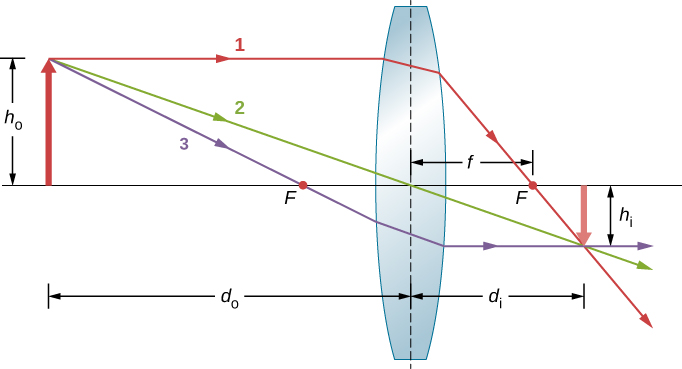
Several important distances appear in the figure. As for a mirror, we define ![]() to be the object distance, or the distance of an object from the center of a lens. The image distance
to be the object distance, or the distance of an object from the center of a lens. The image distance ![]() is defined to be the distance of the image from the center of a lens. The height of the object and the height of the image are indicated by
is defined to be the distance of the image from the center of a lens. The height of the object and the height of the image are indicated by ![]() and
and ![]() , respectively. Images that appear upright relative to the object have positive heights, and those that are inverted have negative heights. By using the rules of ray tracing and making a scale drawing with paper and pencil, like that in (Figure), we can accurately describe the location and size of an image. But the real benefit of ray tracing is in visualizing how images are formed in a variety of situations.
, respectively. Images that appear upright relative to the object have positive heights, and those that are inverted have negative heights. By using the rules of ray tracing and making a scale drawing with paper and pencil, like that in (Figure), we can accurately describe the location and size of an image. But the real benefit of ray tracing is in visualizing how images are formed in a variety of situations.
Oblique Parallel Rays and Focal Plane
We have seen that rays parallel to the optical axis are directed to the focal point of a converging lens. In the case of a diverging lens, they come out in a direction such that they appear to be coming from the focal point on the opposite side of the lens (i.e., the side from which parallel rays enter the lens). What happens to parallel rays that are not parallel to the optical axis ((Figure))? In the case of a converging lens, these rays do not converge at the focal point. Instead, they come together on another point in the plane called the focal plane. The focal plane contains the focal point and is perpendicular to the optical axis. As shown in the figure, parallel rays focus where the ray through the center of the lens crosses the focal plane.
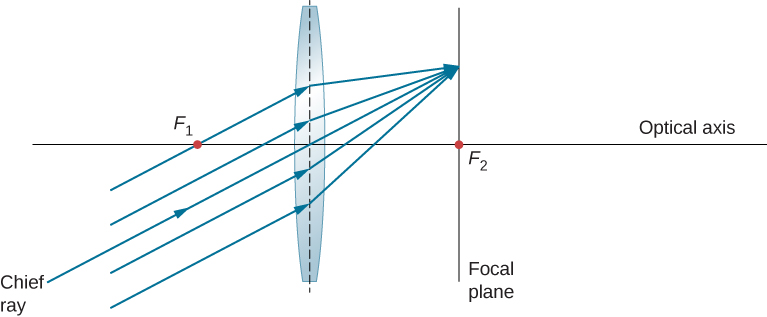
Thin-Lens Equation
Ray tracing allows us to get a qualitative picture of image formation. To obtain numeric information, we derive a pair of equations from a geometric analysis of ray tracing for thin lenses. These equations, called the thin-lens equation and the lens maker’s equation, allow us to quantitatively analyze thin lenses.
Consider the thick bi-convex lens shown in (Figure). The index of refraction of the surrounding medium is ![]() (if the lens is in air, then
(if the lens is in air, then ![]() ) and that of the lens is
) and that of the lens is ![]() . The radii of curvatures of the two sides are
. The radii of curvatures of the two sides are ![]() . We wish to find a relation between the object distance
. We wish to find a relation between the object distance ![]() , the image distance
, the image distance ![]() , and the parameters of the lens.
, and the parameters of the lens.
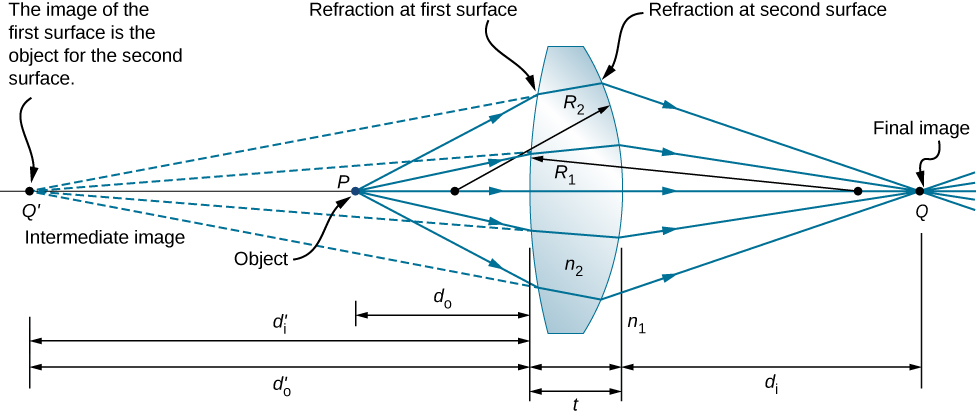
To derive the thin-lens equation, we consider the image formed by the first refracting surface (i.e., left surface) and then use this image as the object for the second refracting surface. In the figure, the image from the first refracting surface is ![]() , which is formed by extending backwards the rays from inside the lens (these rays result from refraction at the first surface). This is shown by the dashed lines in the figure. Notice that this image is virtual because no rays actually pass through the point
, which is formed by extending backwards the rays from inside the lens (these rays result from refraction at the first surface). This is shown by the dashed lines in the figure. Notice that this image is virtual because no rays actually pass through the point ![]() . To find the image distance
. To find the image distance ![]() corresponding to the image
corresponding to the image ![]() , we use (Figure). In this case, the object distance is
, we use (Figure). In this case, the object distance is ![]() , the image distance is
, the image distance is ![]() , and the radius of curvature is
, and the radius of curvature is ![]() . Inserting these into (Figure) gives
. Inserting these into (Figure) gives
The image is virtual and on the same side as the object, so ![]() and
and ![]() . The first surface is convex toward the object, so
. The first surface is convex toward the object, so ![]() .
.
To find the object distance for the object Q formed by refraction from the second interface, note that the role of the indices of refraction ![]() and
and ![]() are interchanged in (Figure). In (Figure), the rays originate in the medium with index
are interchanged in (Figure). In (Figure), the rays originate in the medium with index ![]() , whereas in (Figure), the rays originate in the medium with index
, whereas in (Figure), the rays originate in the medium with index ![]() . Thus, we must interchange
. Thus, we must interchange ![]() and
and ![]() in (Figure). In addition, by consulting again (Figure), we see that the object distance is
in (Figure). In addition, by consulting again (Figure), we see that the object distance is ![]() and the image distance is
and the image distance is ![]() . The radius of curvature is
. The radius of curvature is ![]() Inserting these quantities into (Figure) gives
Inserting these quantities into (Figure) gives
The image is real and on the opposite side from the object, so ![]() and
and ![]() . The second surface is convex away from the object, so
. The second surface is convex away from the object, so ![]() . (Figure) can be simplified by noting that
. (Figure) can be simplified by noting that ![]() , where we have taken the absolute value because
, where we have taken the absolute value because ![]() is a negative number, whereas both
is a negative number, whereas both ![]() and t are positive. We can dispense with the absolute value if we negate
and t are positive. We can dispense with the absolute value if we negate ![]() , which gives
, which gives ![]() . Inserting this into (Figure) gives
. Inserting this into (Figure) gives
Summing (Figure) and (Figure) gives
In the thin-lens approximation, we assume that the lens is very thin compared to the first image distance, or ![]() (or, equivalently,
(or, equivalently, ![]() ). In this case, the third and fourth terms on the left-hand side of (Figure) cancel, leaving us with
). In this case, the third and fourth terms on the left-hand side of (Figure) cancel, leaving us with
Dividing by ![]() gives us finally
gives us finally
The left-hand side looks suspiciously like the mirror equation that we derived above for spherical mirrors. As done for spherical mirrors, we can use ray tracing and geometry to show that, for a thin lens,
where f is the focal length of the thin lens (this derivation is left as an exercise). This is the thin-lens equation. The focal length of a thin lens is the same to the left and to the right of the lens. Combining (Figure) and (Figure) gives
which is called the lens maker’s equation. It shows that the focal length of a thin lens depends only of the radii of curvature and the index of refraction of the lens and that of the surrounding medium. For a lens in air, ![]() and
and ![]() , so the lens maker’s equation reduces to
, so the lens maker’s equation reduces to
Sign conventions for lenses
To properly use the thin-lens equation, the following sign conventions must be obeyed:
 is positive if the image is on the side opposite the object (i.e., real image); otherwise,
is positive if the image is on the side opposite the object (i.e., real image); otherwise,  is negative (i.e., virtual image).
is negative (i.e., virtual image).- f is positive for a converging lens and negative for a diverging lens.
- R is positive for a surface convex toward the object, and negative for a surface concave toward object.
Magnification
By using a finite-size object on the optical axis and ray tracing, you can show that the magnification m of an image is
(where the three lines mean “is defined as”). This is exactly the same equation as we obtained for mirrors (see (Figure)). If ![]() , then the image has the same vertical orientation as the object (called an “upright” image). If
, then the image has the same vertical orientation as the object (called an “upright” image). If ![]() , then the image has the opposite vertical orientation as the object (called an “inverted” image).
, then the image has the opposite vertical orientation as the object (called an “inverted” image).
Using the Thin-Lens Equation
The thin-lens equation and the lens maker’s equation are broadly applicable to situations involving thin lenses. We explore many features of image formation in the following examples.
Consider a thin converging lens. Where does the image form and what type of image is formed as the object approaches the lens from infinity? This may be seen by using the thin-lens equation for a given focal length to plot the image distance as a function of object distance. In other words, we plot
for a given value of f. For ![]() , the result is shown in part (a) of (Figure).
, the result is shown in part (a) of (Figure).
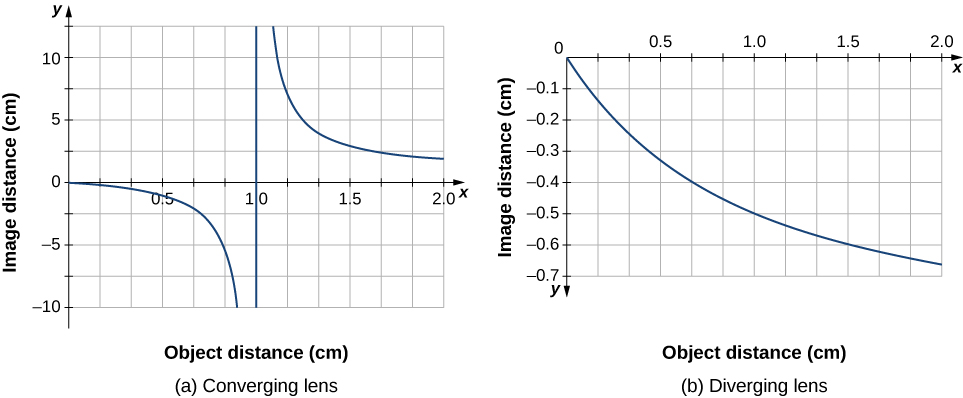
An object much farther than the focal length f from the lens should produce an image near the focal plane, because the second term on the right-hand side of the equation above becomes negligible compared to the first term, so we have ![]() This can be seen in the plot of part (a) of the figure, which shows that the image distance approaches asymptotically the focal length of 1 cm for larger object distances. As the object approaches the focal plane, the image distance diverges to positive infinity. This is expected because an object at the focal plane produces parallel rays that form an image at infinity (i.e., very far from the lens). When the object is farther than the focal length from the lens, the image distance is positive, so the image is real, on the opposite side of the lens from the object, and inverted (because
This can be seen in the plot of part (a) of the figure, which shows that the image distance approaches asymptotically the focal length of 1 cm for larger object distances. As the object approaches the focal plane, the image distance diverges to positive infinity. This is expected because an object at the focal plane produces parallel rays that form an image at infinity (i.e., very far from the lens). When the object is farther than the focal length from the lens, the image distance is positive, so the image is real, on the opposite side of the lens from the object, and inverted (because ![]() ). When the object is closer than the focal length from the lens, the image distance becomes negative, which means that the image is virtual, on the same side of the lens as the object, and upright.
). When the object is closer than the focal length from the lens, the image distance becomes negative, which means that the image is virtual, on the same side of the lens as the object, and upright.
For a thin diverging lens of focal length ![]() , a similar plot of image distance vs. object distance is shown in part (b). In this case, the image distance is negative for all positive object distances, which means that the image is virtual, on the same side of the lens as the object, and upright. These characteristics may also be seen by ray-tracing diagrams (see (Figure)).
, a similar plot of image distance vs. object distance is shown in part (b). In this case, the image distance is negative for all positive object distances, which means that the image is virtual, on the same side of the lens as the object, and upright. These characteristics may also be seen by ray-tracing diagrams (see (Figure)).

To see a concrete example of upright and inverted images, look at (Figure), which shows images formed by converging lenses when the object (the person’s face in this case) is place at different distances from the lens. In part (a) of the figure, the person’s face is farther than one focal length from the lens, so the image is inverted. In part (b), the person’s face is closer than one focal length from the lens, so the image is upright.
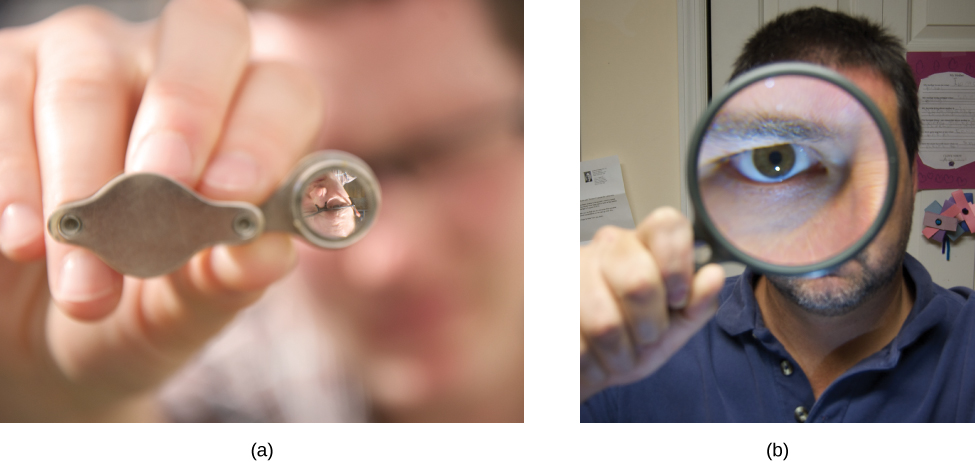
Work through the following examples to better understand how thin lenses work.
Step 1. Determine whether ray tracing, the thin-lens equation, or both would be useful. Even if ray tracing is not used, a careful sketch is always very useful. Write symbols and values on the sketch.
Step 2. Identify what needs to be determined in the problem (identify the unknowns).
Step 3. Make a list of what is given or can be inferred from the problem (identify the knowns).
Step 4. If ray tracing is required, use the ray-tracing rules listed near the beginning of this section.
Step 5. Most quantitative problems require the use of the thin-lens equation and/or the lens maker’s equation. Solve these for the unknowns and insert the given quantities or use both together to find two unknowns.
Step 7. Check to see if the answer is reasonable. Are the signs correct? Is the sketch or ray tracing consistent with the calculation?
Using the Lens Maker’s Equation Find the radius of curvature of a biconcave lens symmetrically ground from a glass with index of refractive 1.55 so that its focal length in air is 20 cm (for a biconcave lens, both surfaces have the same radius of curvature).
Strategy Use the thin-lens form of the lens maker’s equation:
where ![]() and
and ![]() . Since we are making a symmetric biconcave lens, we have
. Since we are making a symmetric biconcave lens, we have ![]() .
.
Solution We can determine the radius R of curvature from
Solving for R and inserting ![]() gives
gives
Converging Lens and Different Object Distances Find the location, orientation, and magnification of the image for an 3.0 cm high object at each of the following positions in front of a convex lens of focal length 10.0 cm. ![]() ,
, ![]() , and
, and ![]() .
.
Strategy We start with the thin-lens equation ![]() . Solve this for the image distance
. Solve this for the image distance ![]() and insert the given object distance and focal length.
and insert the given object distance and focal length.
Solution
- For
 , this gives
, this gives

The image is positive, so the image, is real, is on the opposite side of the lens from the object, and is 12.6 cm from the lens. To find the magnification and orientation of the image, use

The negative magnification means that the image is inverted. Since , the image is smaller than the object. The size of the image is given by
, the image is smaller than the object. The size of the image is given by

- For


The image distance is negative, so the image is virtual, is on the same side of the lens as the object, and is 10 cm from the lens. The magnification and orientation of the image are found from

The positive magnification means that the image is upright (i.e., it has the same orientation as the object). Since , the image is larger than the object. The size of the image is
, the image is larger than the object. The size of the image is

- For


The image distance is positive, so the image is real, is on the opposite side of the lens from the object, and is 20.0 cm from the lens. The magnification is

The negative magnification means that the image is inverted. Since , the image is the same size as the object.
, the image is the same size as the object.
When solving problems in geometric optics, we often need to combine ray tracing and the lens equations. The following example demonstrates this approach.
Choosing the Focal Length and Type of Lens To project an image of a light bulb on a screen 1.50 m away, you need to choose what type of lens to use (converging or diverging) and its focal length ((Figure)). The distance between the lens and the lightbulb is fixed at 0.75 m. Also, what is the magnification and orientation of the image?
Strategy The image must be real, so you choose to use a converging lens. The focal length can be found by using the thin-lens equation and solving for the focal length. The object distance is ![]() and the image distance is
and the image distance is ![]() .
.
Solution Solve the thin lens for the focal length and insert the desired object and image distances:

The magnification is
Significance The minus sign for the magnification means that the image is inverted. The focal length is positive, as expected for a converging lens. Ray tracing can be used to check the calculation (see (Figure)). As expected, the image is inverted, is real, and is larger than the object.
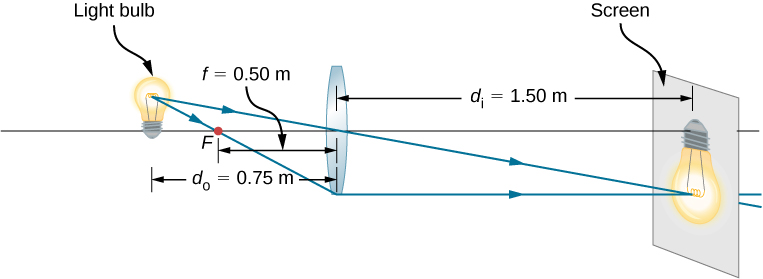
Summary
- Two types of lenses are possible: converging and diverging. A lens that causes light rays to bend toward (away from) its optical axis is a converging (diverging) lens.
- For a converging lens, the focal point is where the converging light rays cross; for a diverging lens, the focal point is the point from which the diverging light rays appear to originate.
- The distance from the center of a thin lens to its focal point is called the focal length f.
- Ray tracing is a geometric technique to determine the paths taken by light rays through thin lenses.
- A real image can be projected onto a screen.
- A virtual image cannot be projected onto a screen.
- A converging lens forms either real or virtual images, depending on the object location; a diverging lens forms only virtual images.
Conceptual Questions
You can argue that a flat piece of glass, such as in a window, is like a lens with an infinite focal length. If so, where does it form an image? That is, how are ![]() and
and ![]() related?
related?
When you focus a camera, you adjust the distance of the lens from the film. If the camera lens acts like a thin lens, why can it not be a fixed distance from the film for both near and distant objects?
The focal length of the lens is fixed, so the image distance changes as a function of object distance.
A thin lens has two focal points, one on either side of the lens at equal distances from its center, and should behave the same for light entering from either side. Look backward and forward through a pair of eyeglasses and comment on whether they are thin lenses.
Will the focal length of a lens change when it is submerged in water? Explain.
Yes, the focal length will change. The lens maker’s equation shows that the focal length depends on the index of refraction of the medium surrounding the lens. Because the index of refraction of water differs from that of air, the focal length of the lens will change when submerged in water.
Problems
How far from the lens must the film in a camera be, if the lens has a 35.0-mm focal length and is being used to photograph a flower 75.0 cm away? Explicitly show how you follow the steps in the (Figure).
A certain slide projector has a 100 mm-focal length lens. (a) How far away is the screen if a slide is placed 103 mm from the lens and produces a sharp image? (b) If the slide is 24.0 by 36.0 mm, what are the dimensions of the image? Explicitly show how you follow the steps in the (Figure).
a. ![]() ;
;
b. ![]() , so that
, so that 
A doctor examines a mole with a 15.0-cm focal length magnifying glass held 13.5 cm from the mole. (a) Where is the image? (b) What is its magnification? (c) How big is the image of a 5.00 mm diameter mole?
A camera with a 50.0-mm focal length lens is being used to photograph a person standing 3.00 m away. (a) How far from the lens must the film be? (b) If the film is 36.0 mm high, what fraction of a 1.75-m-tall person will fit on it? (c) Discuss how reasonable this seems, based on your experience in taking or posing for photographs.
a.  ;
;
b. ![]() , so the maximum height is
, so the maximum height is
*** QuickLaTeX cannot compile formula:
\frac{0.036\phantom{\rule{0.2em}{0ex}}\text{m}}{1.695\phantom{\rule{0.2em}{0ex}}×\phantom{\rule{0.2em}{0ex}}{10}^{-2}}=2.12\phantom{\rule{0.2em}{0ex}}\text{m}⇒\text{100%}\phantom{\rule{0.2em}{0ex}}
*** Error message:
Unicode character ⇒ (U+21D2)
leading text: ...=2.12\phantom{\rule{0.2em}{0ex}}\text{m}⇒
File ended while scanning use of \text@.
Emergency stop.
;
c. This seems quite reasonable, since at 3.00 m it is possible to get a full length picture of a person.
A camera lens used for taking close-up photographs has a focal length of 22.0 mm. The farthest it can be placed from the film is 33.0 mm. (a) What is the closest object that can be photographed? (b) What is the magnification of this closest object?
Suppose your 50.0 mm-focal length camera lens is 51.0 mm away from the film in the camera. (a) How far away is an object that is in focus? (b) What is the height of the object if its image is 2.00 cm high?
a. ![]() ;
;
b. ![]()
What is the focal length of a magnifying glass that produces a magnification of 3.00 when held 5.00 cm from an object, such as a rare coin?
The magnification of a book held 7.50 cm from a 10.0 cm-focal length lens is 3.00. (a) Find the magnification for the book when it is held 8.50 cm from the magnifier. (b) Repeat for the book held 9.50 cm from the magnifier. (c) Comment on how magnification changes as the object distance increases as in these two calculations.
a. Using ![]() ,
, ![]() . Then we can determine the magnification,
. Then we can determine the magnification, ![]() . b.
. b. ![]() and
and ![]() ; c. The magnification m increases rapidly as you increase the object distance toward the focal length.
; c. The magnification m increases rapidly as you increase the object distance toward the focal length.
Suppose a 200 mm-focal length telephoto lens is being used to photograph mountains 10.0 km away. (a) Where is the image? (b) What is the height of the image of a 1000 m high cliff on one of the mountains?
A camera with a 100 mm-focal length lens is used to photograph the sun. What is the height of the image of the sun on the film, given the sun is ![]() in diameter and is
in diameter and is ![]() away?
away?

Use the thin-lens equation to show that the magnification for a thin lens is determined by its focal length and the object distance and is given by ![]() .
.
An object of height 3.0 cm is placed 5.0 cm in front of a converging lens of focal length 20 cm and observed from the other side. Where and how large is the image?
![]()
![]()
An object of height 3.0 cm is placed at 5.0 cm in front of a diverging lens of focal length 20 cm and observed from the other side. Where and how large is the image?
An object of height 3.0 cm is placed at 25 cm in front of a diverging lens of focal length 20 cm. Behind the diverging lens, there is a converging lens of focal length 20 cm. The distance between the lenses is 5.0 cm. Find the location and size of the final image.
83 cm to the right of the converging lens, ![]()
Two convex lenses of focal lengths 20 cm and 10 cm are placed 30 cm apart, with the lens with the longer focal length on the right. An object of height 2.0 cm is placed midway between them and observed through each lens from the left and from the right. Describe what you will see, such as where the image(s) will appear, whether they will be upright or inverted and their magnifications.
Glossary
- converging (or convex) lens
- lens in which light rays that enter it parallel converge into a single point on the opposite side
- diverging (or concave) lens
- lens that causes light rays to bend away from its optical axis
- focal plane
- plane that contains the focal point and is perpendicular to the optical axis
- ray tracing
- technique that uses geometric constructions to find and characterize the image formed by an optical system
- thin-lens approximation
- assumption that the lens is very thin compared to the first image distance

